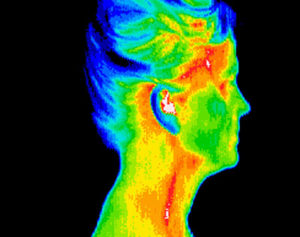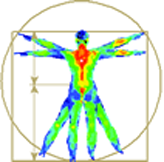Frequently Asked Questions (FAQ)
What is thermography?
Thermography or Digital Infrared Thermal Imaging (DITTI) is a completely non-invasive clinical imaging procedure which aids in monitoring of a number of physiological concerns by illustrating the thermal abnormalities present in the patient's body. It is risk free and provides instant images.
 The practice of thermography is grounded in preventative care and the premise that, if you are able to find problems before the body's functions are impaired, health issues may be more treatable and generally may heal more quickly. Many problems are present in the body long before there is an obvious, physical manifestation. Thermography is a visual representation of what is happening in the body and creates a colorful map of the body for functional comparison. The heat patterns viewed in a thermography scan may be associated with various health concerns. By creating a baseline of your body's own heat patterns, minor changes may be identified earlier with annual thermography.
The practice of thermography is grounded in preventative care and the premise that, if you are able to find problems before the body's functions are impaired, health issues may be more treatable and generally may heal more quickly. Many problems are present in the body long before there is an obvious, physical manifestation. Thermography is a visual representation of what is happening in the body and creates a colorful map of the body for functional comparison. The heat patterns viewed in a thermography scan may be associated with various health concerns. By creating a baseline of your body's own heat patterns, minor changes may be identified earlier with annual thermography.
 While thermography does not diagnose these health issues, it creates a clear map with attention focused on a particular region of interest. Increases in blood supply illustrated by the color representations in a thermogram show where there may be abnormal physiology. Thermography does not show the actual structure, but instead shows the activities within the body that may coincide with disfunction. Thermography does not replace more invasive procedures or other diagnostic tests and is a safe, pain free, radiation free approach that complementary to these other methods of examination.
While thermography does not diagnose these health issues, it creates a clear map with attention focused on a particular region of interest. Increases in blood supply illustrated by the color representations in a thermogram show where there may be abnormal physiology. Thermography does not show the actual structure, but instead shows the activities within the body that may coincide with disfunction. Thermography does not replace more invasive procedures or other diagnostic tests and is a safe, pain free, radiation free approach that complementary to these other methods of examination.
How is it different from other methods of diagnostic assessment?
DITI and its colorful imaging may provide a "visualization" of pain and pathology anywhere on the body. It can also be used in conjunction with and is an excellent addition to anyone's health management program. While X-Rays, CT Scans, Ultrasounds and MRIs are tests that measure the body structures, DITI is uniquely capable of illustrating the physiological changes and metabolic processes within the body. Digital Infrared Thermal Imaging is a non-invasive screening technique that offers clinically relevant information without side effects.
For what is DITI used?
Digital Infrared Thermal Imaging assists in the monitoring of a myriad of different conditions, injuries and diseases like:
- Breast Disease
- Headache
- Vascular Disease
- Stroke Screening
- Arthritis
- Disc Disease
- Back Injuries
- RSD (CRPS)
- Digestive Disorders
- Nerve Damage
- Inflammatory Pain
- Unexplained Pain
- Sprain | Strain
- Dental and TMJ
- Carpal Tunnel Syndrome
- Fibromyalgia
- Referred Pain Syndrome
- Whiplash
- Artery Inflammation
- And more
What is the procedure like?
DITI is not invasive. The test starts with an overview of your medical history prior to partially disrobing so that the scanning can be performed.
How long does the procedure take?
A standard region of interest scan takes approximately 30 minutes, while a full body scan can take up to 1 hour.
How are the scans used?
The images (thermograms) are stored and sent electronically to a Thermologist, who is a medical doctor certified to interpret and write reports. Reports are printed and sent to you directly, and can also be forwarded to your healthcare professional, at your request.
How soon will the report be available?
Reports are prepared and sent within a few business days. You will receive your results within about 1 week from the date of your appointment.
Are Thermograms covered by insurance?
Thermograms are not often covered by insurance however, you may want to contact your insurance company to determine their reimbursement policy & procedure for Thermograms.
Who reads the images and reports?
Thermal images are sent to an interpretation service that employs only Medical Doctors (MD) and Doctors of Osteopathic Medicine (DO) who are all board certified as Thermologists by the American College of Clinical Thermology.
Who certifies your Thermographers?
Thermoagraphy technicians are trained and certified by the American College of Clinical Thermology. The American College of Clinical Thermology is an accredited medical association.
Why do I need to come back in three months for another breast thermoscan?
The most accurate result we can produce is change over time. Before we can start to evaluate any changes, we need to establish an accurate and stable baseline for you. This baseline represents your unique thermal fingerprint, which will only be altered by developing pathology. A baseline cannot be established with only one study, as we would have no way of knowing if this is your normal pattern, or if it is actually changing at the time of your first exam. By comparing two studies three months apart, we are able to judge if your breast physiology is stable and suitable to be used as your normal baseline for continued annual screening.
How do I prepare for my DITI scan?
Preparing for your scan is simple, but crucial for accurate results. Do not have any physical therapy, electromyography, or chiropractic work the same day as your thermography appointment. Do not smoke or participate in vigorous exercise 2 hours before the test. Do not use any lotions, liniments or creams, or shave the day of your scan. Avoid strong sunlight exposure the day of your appointment.
Have more questions?
Please contact us!
